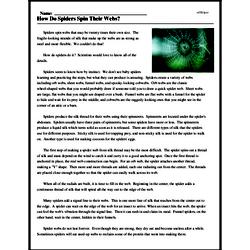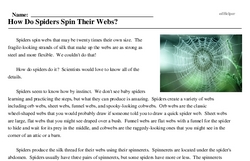How Do Spiders Spin Their Webs?
Spiders spin webs that may be twenty times their own size. The fragile-looking strands of silk that make up the webs are as strong as steel and more flexible. We couldn't do that!
How do spiders do it? Scientists would love to know all of the details.
Spiders seem to know how by instinct. We don't see baby spiders learning and practicing the steps, but what they can produce is amazing. Spiders create a variety of webs including orb webs, sheet webs, funnel webs, and spooky-looking cobwebs. Orb webs are the classic wheel-shaped webs that you would probably draw if someone told you to draw a quick spider web. Sheet webs are large, flat webs that you might see draped over a bush. Funnel webs are flat webs with a funnel for the spider to hide and wait for its prey in the middle, and cobwebs are the raggedy-looking ones that you might see in the corner of an attic or a barn.
Spiders produce the silk thread for their webs using their spinnerets. Spinnerets are located under the spider's abdomen. Spiders usually have three pairs of spinnerets, but some spiders have more or less. The spinnerets produce a liquid silk which turns solid as soon as it is released. There are different types of silk that the spiders use for different purposes. Sticky silk is used for trapping prey, and non-sticky silk is used for the spider to walk on. Another type is used for making cocoons for the spiders' eggs.




